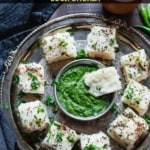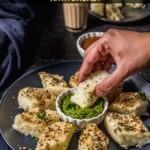On the lookout for a fast Gujarati white dhokla recipe? Use this easy recipe to make Quick rava dhokla in your Quick Pot or stovetop. It’s a crowd-pleaser of course!
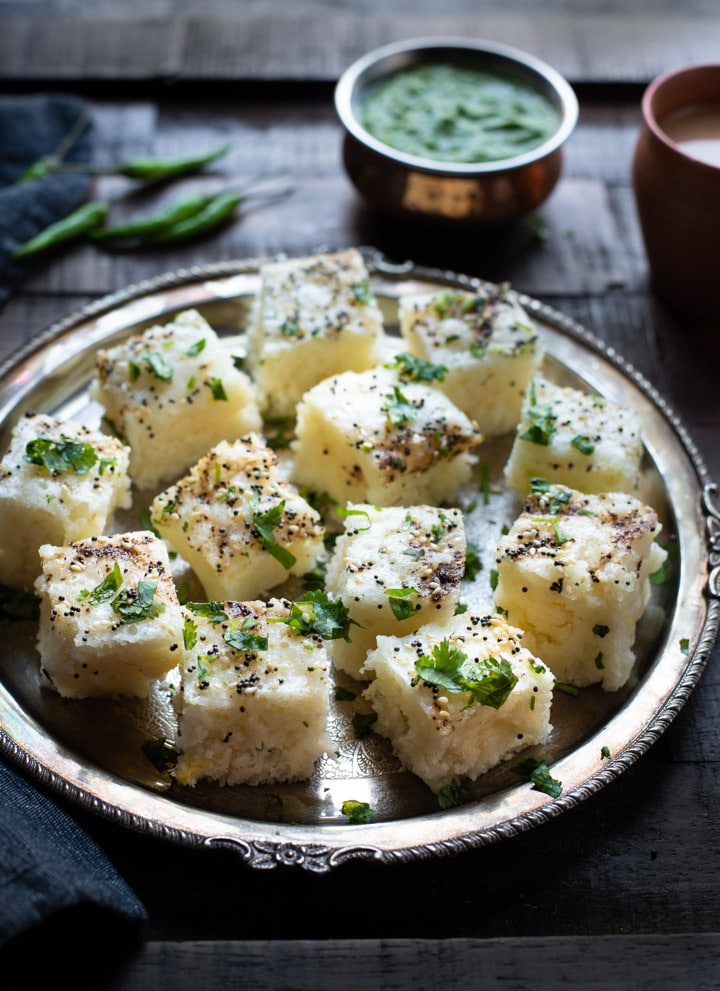
The toughest recipes to recreate are those from childhood. Because whilst you remember how the dish tasted and looked, you may have no idea what went into it. Dhokla was one such dish for me.
I used to be introduced to this white dhokla recipe by my Gujarati friends from school, who used to get this delicious dish for lunch together with green chutney. Soft, spongy, and delicious – it jogged my memory a lot of the idlis my mom used to make.
After cracking the code for khaman (steamed gram flour cake), one other childhood favorite, I made a decision it was time to experiment with this quick version of dhokla too. I reached out to my friends once more, and after a number of messages backwards and forwards on WhatsApp, I used to be capable of nail down this rava dhokla recipe.
Should you are latest to this dish, make sure that to examine out the subsequent few paragraphs, where I share a transient introduction to dhokla.
What’s dhokla?
Dhokla (steamed savory cake) is a quintessential Gujarati dish, similar to nylon khaman. Traditionally crafted from fermented rice and lentil batter, this delightful snack transforms right into a soft and spongy snack when steamed, just like an idli.
This dish traveled with the Gujarati diaspora and has grow to be a preferred dish with vegetarians and vegans across the globe.
Khaman vs Dhokla
Khaman and dhokla, although often used interchangeably, are distinct Gujarati snacks with unique characteristics:
- Ingredients: Dhokla is constituted of a fermented batter of rice and lentils, while khaman is ready using gram flour (besan).
- Color: Dhokla has a whitish color, whereas Khaman is understood for its vibrant, deep yellow hue.
- Texture: Khaman is soft, spongy, and melts in your mouth often called nylon khaman for its texture. Dhokla, while also spongy, is denser in comparison with khaman.
What makes sooji dhokla breakfast/snack?
Quick semolina dhokla is a unbelievable alternative for a mid-meal snack or perhaps a quick breakfast option. With only 5 minutes of prep time, this easy-to-make dish is a top favorite amongst mothers. Here’s why:
- No overnight fermentation is required; it comes together in lower than an hour.
- It’s a great make-ahead snack, and it freezes well, too!
- It tastes equally delicious at room temperature, making it an ideal alternative for varsity or work lunches.
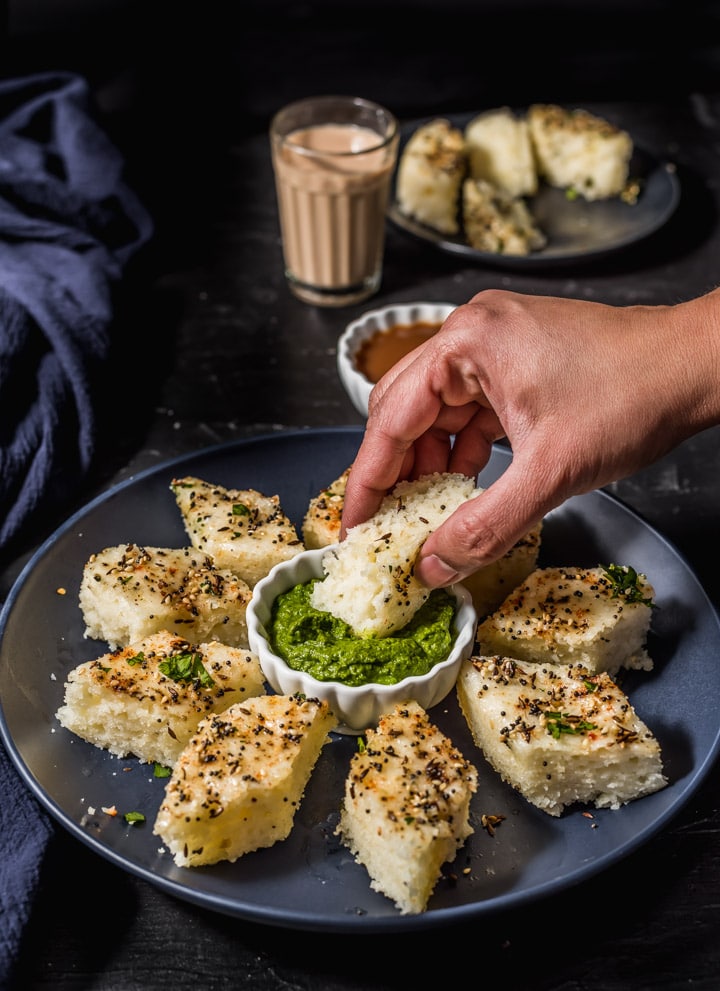
How you can make Suji dhokla
Call it suji dhokla, semolina dhokla, khatta dhokla, or rava dhokla it’s all one and the identical. The name comes from the most important ingredient used for this quick dhokla, which is semolina. Semolina is named suji or rava in India.
What exactly is fruit salt?
Fruit salt, an antacid commonly used to alleviate issues like acidity and heartburn, typically consists of ingredients comparable to baking soda, citric acid, or tartaric acid and will include flavoring agents and sometimes sugar to reinforce taste. Although the precise components may vary amongst brands, their fundamental qualities remain consistent.
Within the context of quick Indian dhokla recipes, fruit salt plays a pivotal role. It has revolutionized the normal dhokla-making process, eliminating the necessity for time-consuming steps comparable to soaking, grinding, and overnight fermentation before steaming. It serves to mimic the results of fermentation, immediately imparting lightness and fluffiness to batters, making it a worthwhile addition to contemporary cooking methods.
Here’s how you can make suji ka dhokla using an Quick Pot
Traditionally, the batter is poured right into a steel plate and steamed using a dhokla cooker, but on this quick rava dhokla recipe, I actually have used an Quick Pot.
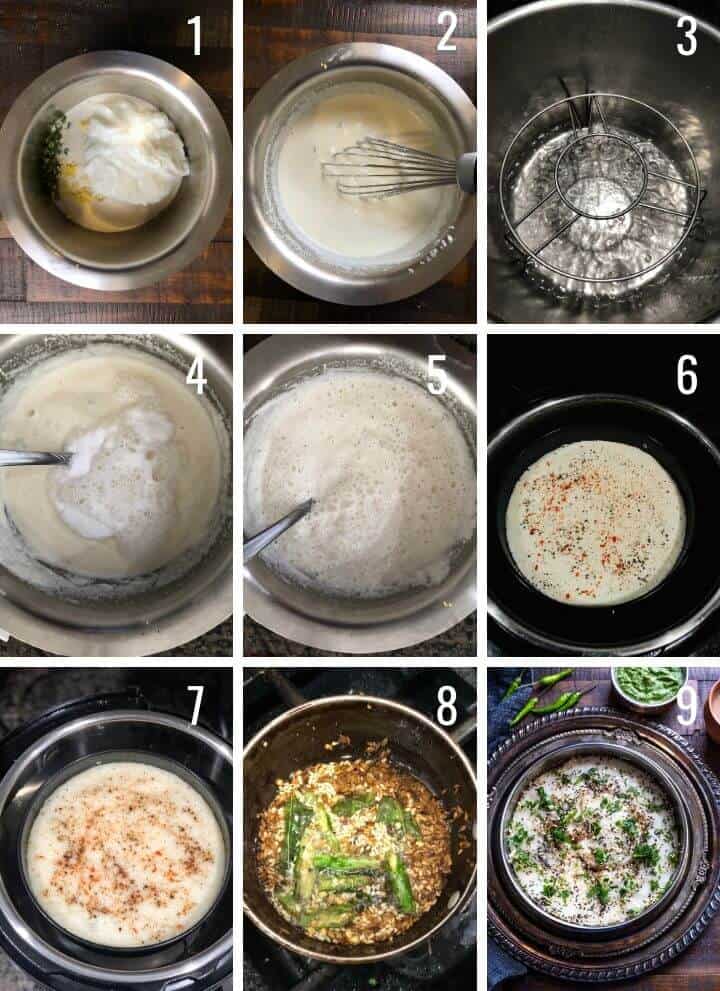
- To make this quick recipe, mix all of the ingredients for the batter (except fruit salt) together to make a smooth, pourable batter. Put aside to let the semolina soak for 15 – 20 minutes.
- Meanwhile, grease a springform cake pan well with somewhat oil or ghee.
- After 15 – 20 minutes, whisk the batter and add more water if needed so the batter is identical consistency because the idli batter.
- Prepare your Quick Pot for steaming the dhokla. Add in 2.5 cups of water and set it on saute function with “more” mode. Once the water starts to boil, press warm/cancel. The quick pot is prepared for steaming.
- Add the Eno fruit salt to the batter and blend it in till it gets incorporated into the batter. Don’t over-mix. The batter will look foamy at this point.
- Place the trivet within the steel inner pot together with the springform pan.
- Transfer the batter to the springform pan. Sprinkle the dhokla batter evenly with Kashmiri chili powder and freshly ground pepper.
- Cover the Quick Pot with the lid and set the valve to the venting position.
- Select the ‘Steam’ function and adjust the pressure to high. Set an EXTERNAL timer for quarter-hour. [Note: When the steam valve is in the venting position, the Instant Pot timer will not work].
- Once the external timer indicates the time is up, hit the cancel button within the Quick Pot.
- Wait for five minutes, after which open the lid. Insert a toothpick right in the middle of the dhokla. If it doesn’t come out clean, steam the dhokla for a further 3-4 minutes till it’s thoroughly cooked.
- Remove the pan fastidiously using tongs.
- If using a springform pan, unhinge the clasp and take away the edges.
- Should you are usually not using a springform pan, run over the perimeters of the pan with a pointy knife and invert the dhokla over a plate. Lift the pan off the dhokla.
- Should you prefer the smoother surface to be on top, invert the dhokla yet another time by keeping a plate on top of the dhokla. Rigorously hold each plates together and flip the underside plate to the highest.
- Remove the plate and cut the dhokla into diamond or square shapes.
Tempering process
- Add oil to a small pan and set it on medium heat.
- Once the oil is hot, add mustard seeds, and once they begin to crackle, add asafoetida, green chilies, and sesame seeds.
- When the sesame starts to brown in about 10-15 seconds, take the pan off the warmth.
- Pour this tempering mixture evenly over the dhokla using a spoon.
- Garnish with finely chopped cilantro.
- Serve warm with green chutney or tamarind chutney.
How you can prepare rava dhokla on a stovetop:
- Prepare the batter: Follow the identical steps to make rava dhokla batter. Grease the stainless-steel bowl or springform pan. Set it aside.
- Arrange for steaming: Select a big wok that may comfortably accommodate the springform pan. Pour 3 cups of water into this pot and convey it to a boil.
- Get the batter ready: Because the water starts boiling, incorporate Eno or fruit salt within the batter.
- Steam the dhokla: Transfer the batter to the greased pan. Gently set this pan on a trivet contained in the wok.
- Cooking time: Cover and steam on medium heat for about 15-20 minutes. The dhokla is finished when a knife inserted into it comes out clean.
- Cool and garnish: Remove the dhokla and let it cool for five to 10 minutes. Then, cut it into small squares and garnish with the tadka and fresh cilantro.
Expert Suggestions
- Add Eno just before steaming: At all times remember to introduce Eno fruit salt into the batter just before you begin the steaming process. Immediate steaming is important to make sure the batter rises accurately. Remember, there’s no have to over-stir – just a number of quick swirls will do the trick.
- Fresh Eno is essential: Fruit salt is the first ingredient chargeable for creating soft and spongy dhokla. Avoid using aged or expired Eno. Ideally, while you add the fruit salt, the batter should visibly lighten and grow to be airy. This transformation indicates that the fruit salt is lively. Should you don’t observe this modification, it’s time to change to a latest batch of fruit salt.
- Check for doneness: To substantiate that your dhokla is thoroughly cooked, insert a toothpick into the middle. If the toothpick comes out clean, your dhokla is prepared. If not, steam it for a further 3-4 minutes.
- Position the steam valve: Make sure that the steam valve is ready to the venting position. This mimics the normal steaming process and ends in light and fluffy dhokla. Should you by chance seal the valve, your dhokla may prove barely denser.
Variations and substitutions
- Eno substitute – Should you don’t have Eno fruit salt, substitute it with 1/2 teaspoon citric acid + 1/2 teaspoon baking soda. Nonetheless, I prefer using Eno because it imparts the dish a greater taste and fluffier texture.
Serving suggestions
Serve this quick dhokla along with your alternative of coriander chutney or tamarind chutney, together with a cup of piping hot masala chai.
Prep and storage instructions
This suji dhokla is a superb alternative for a celebration snack. You’ll be able to prepare it a number of days upfront, and it is going to maintain its delicious taste.
Prep ahead – I actually have also frozen leftover dhokla previously with none significant impact on the taste. To freeze, place it in an airtight freezer-safe container. You’ll be able to reheat it within the microwave without thawing.
Reheating instructions – Warm the leftover dhokla within the microwave or steam it for a number of minutes before serving.
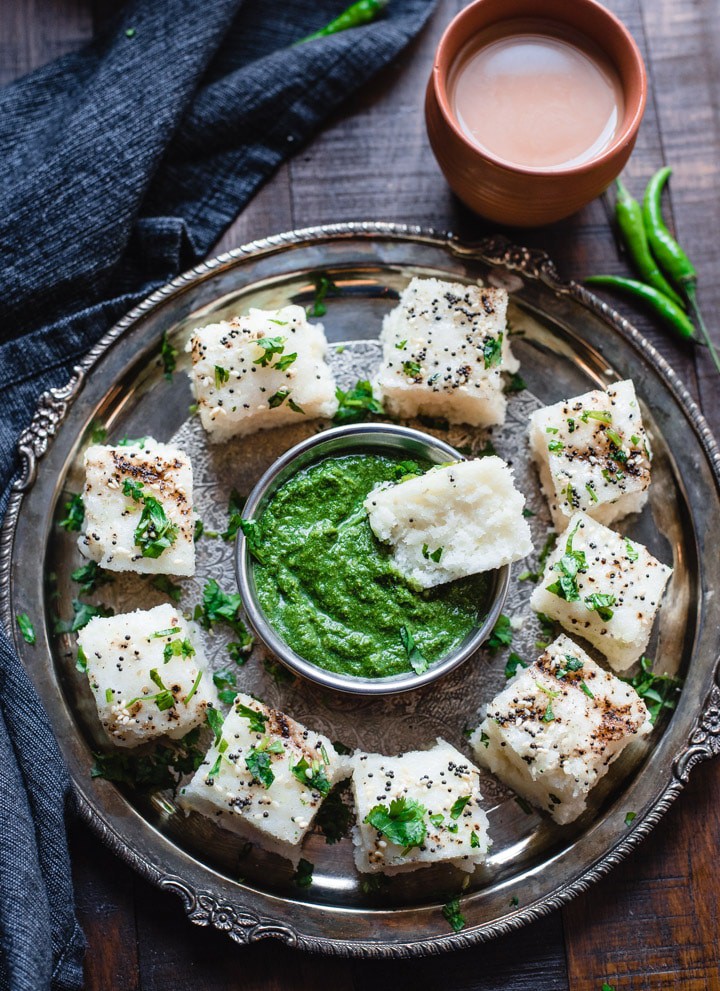
Should you are searching for easy and delicious Indian breakfast recipes, listed here are my top picks,
- Nylon khaman dhokla – Spongy, savory, and with a touch of sweetness, Gujarati nylon khaman dhokla is a lightweight and healthy anytime snack. Get this failproof recipe to make it within the Quick Pot.
- Lemon vermicelli – This delicious and tangy Semiya Upma (Lemon Vermicelli) is just what it’s essential start your day. It’s filling and comes together in quarter-hour from start to complete.
- Sooji upma – a semolina-based breakfast dish that takes lower than half-hour.
- Idli – You’ll love this post if you may have been struggling to get soft and spongy idlis. Learn all my suggestions and tricks to get perfect fermented batter even in winter!
- Buttermilk dosa – Buttermilk dosa – Delicious and soft, this dosa is ideal for breakfast, snacks, and even lunch. Learn how you can make it in a number of easy steps.
- Quick Rava idli – Here’s a quick recipe to enjoy those lovely soft, fluffy quick rava idlis at any time when the mood strikes. Serve with coconut or peanut chutney for a delicious and healthy meal.
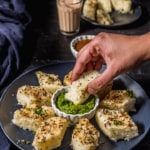
Rava Dhokla Recipe (Quick Pot + Stovetop)
Enjoy easy-to-make rava or semolina dhokla, a soft and savory Gujarati snack prepared with semolina and yogurt. This quick, no-ferment recipe is ideal for a fast breakfast or snack, and will be made in an Quick Pot or on the stovetop.
Pin Print Save Email- 1 cup high-quality semolina rawa or suji
- 1 cup yogurt
- 1 inch piece ginger grated
- 1-2 green chili finely chopped
- 1 teaspoon sugar
- 1 teaspoon salt
- 2 teaspoons oil
- ½ cup water
- 1.5 teaspoons Eno/fruit salt
- ¼ teaspoon freshly ground pepper optional
- ¼ teaspoon Kashmiri chili powder optional
- 2.5 cups water for steaming
For garnishing
- ¼ cup finely chopped cilantro/coriander leaves
Prevent your screen from going dark
Preparing the batter
- Grease a 7-inch springform pan or a steel bowl either using oil or cooking spray. Use a pastry brush if needed to make sure that the bowl is thoroughly greased.
Add semolina, yogurt, sugar, green chili, ginger, oil, salt and water in a mixing bowl. Use a whisk to mix them right into a lump-free batter.
Set it aside for about 15-20 minutes to permit the semolina to absorb the liquid.
After about quarter-hour, whisk the mixture. The consistency of the batter ought to be thick and flowy like idli batter. Add more water as needed starting with one tablespoon at a time to get the proper consistency.
Steaming
Add 2.5 cups of water within the Quick Pot and click on on the Saute function and set it to the ‘More’ mode. Once the water involves a boil, hit warm/cancel.
Add the Eno fruit salt to the batter and blend it in till it gets incorporated into the batter making. Don’t over mix.
Place the trivet within the steel inner pot together with the springform pan.
Transfer the batter into the springform pan. Sprinkle the dhokla batter evenly with freshly ground pepper and Kashmiri chili powder.
Cover the Quick Pot with the lid and set the valve to the venting position.
Select the ‘Steam’ function and adjust the pressure to high. Set ten EXTERNAL timer to quarter-hour. [Note: When the steam valve is in the venting position, the Instant Pot timer will not work]. Once the external timer indicates the time is up, hit the cancel button within the Quick Pot.
Wait for five minutes after which open the lid. Insert a toothpick right in the middle of the dhokla. If it doesn’t come out clean, steam the dhokla for a further 3-4 minutes till it’s thoroughly cooked.
Remove the pan fastidiously using tongs.
If using a springform pan, unhinge the clasp and take away the edges.
Should you are usually not using a springform pan, run over the perimeters of the pan with a pointy knife and invert the dhokla over a plate. Lift the pan off the dhokla.
Should you prefer the smoother surface to be on top, invert the dhokla yet another time by keeping a plate on top of the dhokla. Rigorously hold each plates together and flip the underside plate to the highest.
Remove the plate and cut the dhokla into diamond shapes.
Tempering process
Add oil to a small pan and set it on medium heat.
Once the oil is hot, add mustard seeds and once they begin to crackle, add asafoetida, green chilies, and sesame seeds.
When the sesame starts to brown in about 10-15 seconds, take the pan off heat.
Pour this tempering mixture evenly over the dhokla using a spoon.
Garnish with finely chopped cilantro.
Serve warm with green chutney or tamarind chutney.
- Prepare the batter: Follow the identical steps to make rava dhokla batter. Grease the stainless-steel bowl or springform pan.
- Arrange for steaming: Select a big vessel that may comfortably accommodate the springform pan. Pour 2 to three cups of water into this pot and convey it to a boil.
- Get the batter ready: Because the water starts boiling, incorporate Eno or fruit salt within the batter.
- Steam the dhokla: Transfer the batter to the greased pan. Gently set this pan on a trivet inside the massive vessel.
- Cooking time: Cover and steam on medium heat for about 15-20 minutes. The dhokla is finished when a knife inserted into it comes out clean.
- Cool and garnish: Remove the dhokla and let it cool for five to 10 minutes. Then, cut it into small squares and garnish with the tadka and fresh cilantro.
- I exploit a springform pan since it makes removing the khaman from the pan a breeze.
- Variation – when you do not need Eno fruit salt, replace it with 1/2 teaspoon citric acid + 1/2 teaspoon baking soda. I don’t just like the taste of baking soda on this dish, so I at all times use Eno.
- At all times make sure that to steam immediately after adding Eno, or your batter will find yourself flat.
- Check for doneness – Insert a toothpick right in the middle of the dhokla. If it doesn’t come out clean, steam the dhokla for a further 3-4 minutes till it’s thoroughly cooked.
- The steam valve kept at venting vs sealing – The steam valve must be at venting to copy the steaming function involved in traditionally making dhokla. Should you set the valve to sealing, the dhokla finally ends up a tad bit denser.
Disclaimer: Approximate dietary information is provided as a courtesy and may vary depending on the precise ingredients/brands used. If you may have health issues, please work with a registered dietician or nutritionist.
Serving: 1pieceCalories: 62kcalCarbohydrates: 9gProtein: 2gFat: 2gSaturated Fat: 2gCholesterol: 2mgSodium: 165mgPotassium: 43mgFiber: 1gSugar: 1gVitamin A: 58IUVitamin C: 9mgCalcium: 23mgIron: 1mg
Food plan: Nut-free, Vegetarian
Course: Breakfast
Method: Quick Pot
Cuisine: Indian
This post was originally written on Jan 17, 2020, and was republished with additional information on Dec 12, 2023.



